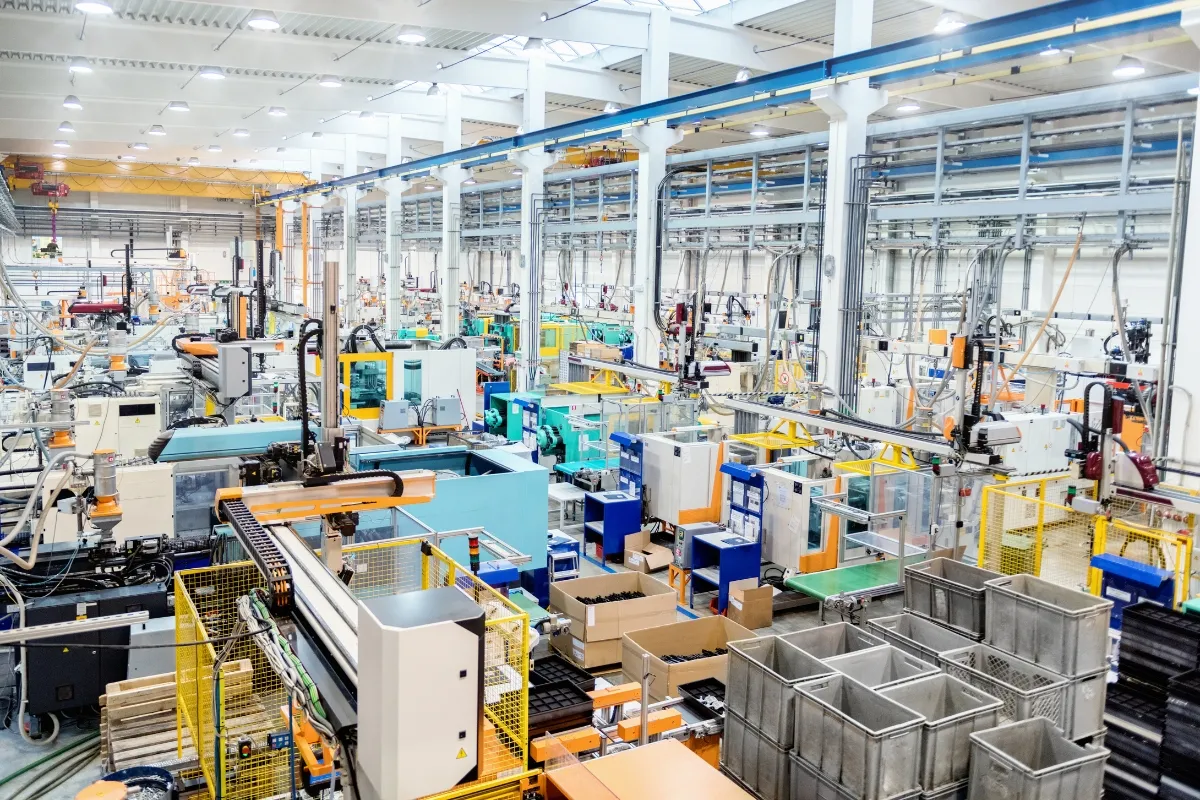
Across asset-intensive industries, maximizing efficiency is important for controlling costs and cutting carbon emissions. In manufacturing, efficiency has a special meaning and plays a central role. Manufacturing efficiency helps you quantify how consistently you are producing the best quality products at the lowest costs. It’s an important part of the process of finding the efficiencies that deliver a competitive edge.
What is manufacturing efficiency?
Manufacturing efficiency is how you produce products at the lowest possible total cost. It’s all about creating as much as you can with the resources you have, while reducing the time, materials, and energy you spend.
Efficiency is not the same as productivity, though. While manufacturing productivity focuses on increasing product quality, manufacturing efficiency tries to increase the effectiveness and quality of the work you do.
Manufacturing efficiency, which some people call manufacturing operational efficiency, is usually expressed as a percentage, with 100% representing maximum efficiency, where you produce quality goods at the lowest possible cost. In practice, however, most manufacturing firms typically operate at around 60-80%, with issues such as defective goods and poor-quality raw materials pulling the numbers down.
Why is efficiency important in manufacturing?
Unlike productivity, manufacturing efficiency encourages you to consider more than just input and output. Instead, it helps you focus on the bigger picture, looking at every aspect of your manufacturing process, including everything from ensuring quality and effectiveness of work to minimizing risk and reducing total losses.
Achieving manufacturing efficiency is a process of continuous improvement. You must also capitalize on new technology as it emerges to allow you to make faster and better decisions to keep ahead of what’s seen as the “gold standard” within your industry.
Focusing on efficiency is important for manufacturing companies, but it shouldn’t come at the cost of productivity. You could be the most efficient firm in your industry, but if you can’t meet customer demand, you lose both business and revenue. Instead, you want to find a steady balance between efficiency and productivity to optimize your output while minimizing potential losses.
How do you calculate manufacturing efficiency?
At its most basic level, you can calculate your manufacturing efficiency by dividing the standard output by your actual output and then expressing that as a percentage.
Actual output
Calculate your actual output by dividing your total output by your total input.
For example:
- You create 100 products for $500
- The input is $500 worth of costs
- The output is 100 products
The actual output is $500 of costs / 100 products = $5 per product
Standard output
Calculate standard output by looking at your historical data, using an industry benchmark or an efficiency figure you might find in a competitor’s report.
If you find that a competitor can produce 120 products for $500, then their output is $500 of costs / 120 products = $4.17 per product. Therefore, your standard output is $5 per product / $4.17 per product = 1.1999
That figure suggests it costs you roughly 20% (19.9%) more to produce a single product than your competitor. That makes you nearly 20% less efficient.
What are examples of manufacturing efficiency KPIs?
There are several key performance indicators (KPIs) that can help you better understand where you are in your manufacturing efficiency journey and the steps you can take to make improvements.
Overall equipment effectiveness (OEE)
It’s a common efficiency measure that helps you determine how much of a product you make versus how much you could make.
You take how available your equipment is (availability), how it performs (performance), and the kind of quality it produces (quality). Together, you get a strong KPI for identifying losses, benchmarking progress, and eliminating waste.
You can calculate it simply by multiplying the three OEE factors:
Availability X performance rate X quality rate = OEE
Material yield
Your material yield is the ratio of how many raw materials you should use compared to the amount of material you do use. It shows you how efficient you are at converting your raw materials into finished products.
Materials you should use / materials you do use = material yield
This simple KPI can be more complicated if you use multiple raw materials to make a product, although having a “bill of materials” or “ingredients list” close at hand makes the calculation a lot easier.
Labor Efficiency
Labor efficiency is a measure of the optimum output versus the actual output to produce a certain number of finished products. It can be useful if you have an under-resourced production process and want to know how a reduction in your workforce has affected your efficiency.
Actual output / optimum output = labor efficiency
This KPI only applies where your resource level is the primary factor in your output. If your resource level is not the primary factor in your output, then use OEE instead.
How can you improve manufacturing efficiency?
Improving the efficiency of your manufacturing process is essential to staying competitive. Even if your manufacturing processes are more efficient than the competition now, you should stay on the lookout for new technology, software, and machinery to maintain that lead.
It’s a process that needs a multipronged approach.
Identify and eliminate waste
Some amount of waste is inevitable in most manufacturing processes, but you should strive for the lowest levels. Waste, in this context, is a broad term that can refer to raw materials, labor, energy, and even time. However, the biggest form of waste for most manufacturers is their materials.
There are several steps that you can take to reduce material waste. First, you should look at the processes which create waste in your business and optimize them. You can also explore ways to recycle more of the waste you create by converting it into new materials or selling it to other businesses.
Over the longer term, you should consider process changes you can make and operations you can improve to produce less waste. This could be by investing in new assets and equipment or designing new parts that improve your material yield.
Improve production line efficiency
Your production line is the foundation of all your processes, so when it comes to improving your manufacturing operational efficiency, it makes sense to start here. Measuring the throughput of your production lines, which tells you how many units you produce over a specific period, is one of the easiest ways to identify areas where you can improve efficiency.
If your throughput is low on specific equipment, you need to ask yourself why. It could be that your operators need more training or that it’s time to upgrade to better machines.
Standardize work
Everyone has their own way of doing things, but when it comes to manufacturing, there’s no room for individuality. Standardizing even the simplest tasks can help you maximize efficiency by reducing unscheduled downtime and increasing overall product quality.
A good place to start is by creating a checklist for each workspace and making sure that everyone in that workspace follows it. If they don’t, you can make them accountable and provide further training where necessary.
Engage and train your employees
Your employees should be the first people you go to if your process is plagued by downtime. They’re working with it every day, so they should have plenty of ideas about how to make the process more efficient. These small opportunities for improvement can add up to big efficiency gains, so make sure they know how to make any suggestions or complaints.
Feedback from your employees may help you identify the need for additional training. Providing practical, hands-on training in the manufacturing process and the latest technology can help you make sure every employee has the skills to complete their tasks in the most efficient way and stand in for each other to reduce unscheduled downtime.
Maintain equipment before it breaks
Regular inspections and maintenance of your assets and equipment help you identify issues and repair them before they fail. By implementing a program of preventive maintenance, you give your assets the care they need while they’re still running to actively reduce the risk of costly repairs and delays that come with unscheduled downtime.
How can maintenance software for manufacturing plants help?
To achieve manufacturing efficiency, you need to have complete visibility of every aspect of your maintenance operations, including assets, people, and parts.
A modern asset management platform lets you see the whole manufacturing operational efficiency picture. You can capture real-time data on the go, centralize that data so it’s safe and searchable, and manage your assets, resources, and materials all from one place.
When you rely on old-fashioned paper-based approaches or spreadsheets, your efficiency suffers before your manufacturing process has even begun. But paper and spreadsheets do more than just slow you down. They also trip you up with unreliable, out-of-date data.
Manufacturing efficiency is all about creating as much as you can with the resources that you have while reducing the amounts of time, material, and energy you use. You can improve your efficiency by eliminating waste, improving your product line, standardizing work, engaging and training your employees, and maintaining equipment before it breaks. A robust, modern maintenance management software solution helps you see the whole manufacturing operational efficiency picture and provides you with all the tools you need to build reliable manufacturing lines that maximize efficiency without compromising safety.








